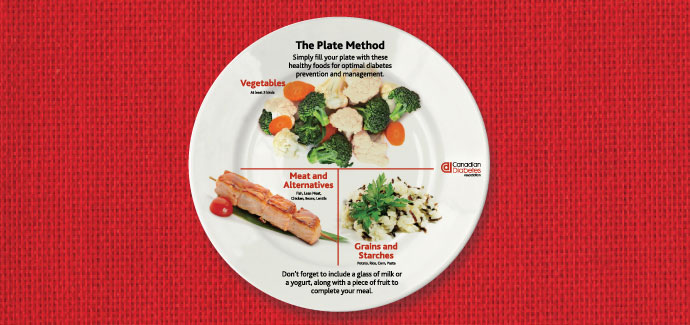
Healthy eating for people living with diabetes
by Carrie Henderson, registered dietitian, Diabetes Care and Research Program
Diabetes is a condition where your body can’t properly use and store food for energy. The body uses glucose, a form of sugar, as fuel. Glucose comes from foods that contain carbohydrates such as fruit, milk, some vegetables, starchy foods and sugar. Glucose enters your blood during digestion, where we sometimes refer to it as “blood sugar”.
The body produces insulin to regulate the amount of glucose in your blood. Some people with diabetes can’t produce insulin at all. Others produce some insulin, but their bodies can’t use it properly. Because insulin plays such a vital role in regulating blood sugar, it’s especially important for people living with diabetes to be mindful of what they’re eating.
VIDEO: watch this Q&A with two of our diabetes experts
Balancing blood sugar with good eating habits
• Eat three meals per day at regular times and space meals no more than six hours apart. You may benefit from a healthy snack in between. Eating at regular times helps your body control blood sugar levels.
• Make time for breakfast. Skipping breakfast can lead to fluctuations in blood sugar levels and can cause over eating later in the day.
• Limit sugars and sweets such as sugar, regular pop, desserts, candies, jam and honey. The more sugar you eat, the higher your blood glucose will be. Artificial sweeteners can be useful as they do not cause a rise in blood sugar.
• Eat more high-fibre foods such as whole grain breads and cereals, lentils, dried beans and peas, brown rice, vegetables and fruits. Foods high in fibre may help you feel full and may lower blood glucose (sugar) and cholesterol levels.
• Limit the amount of high-fat food you eat such as fried foods, chips and pastries. High-fat foods may cause you to gain weight. A healthy weight helps with blood sugar control and is healthier for your heart.
• Choose water. Staying hydrated is important. Stick with water as regular pop, and even 100% fruit juice can cause your blood sugar levels to spike.
The plate method: a cheat sheet for for people living with diabetes
In general, most people living with diabetes are encouraged to use the plate method to dictate their intake of protein, carbohydrate and veggies. This is a visual guide that helps you determine how much of each food to eat.
This method divides a plate into three sections: half for veggies, one quarter for meat and alternatives, and one final quarter for grains and starches.

What should you put on your plate?
• Fill half your plate with vegetables.
WHY? Vegetables are high in nutrients and low in calories. Vegetables with lots of soluble fiber, like broccoli and brussel sprouts, may help to reduce blood sugar swings by slowing the digestion of food and delaying the absorption of sugar into the blood.
• Include starchy foods such as whole grain breads and cereals, rice, noodles, or potatoes at every meal.
WHY? Starchy foods are broken down into glucose, which your body needs for energy.
• Include fish, lean meats, low-fat cheeses, eggs, or vegetarian protein choices as part of your meal.
WHY? Protein may help slow the absorption of sugar into your blood.
• Moderate the amount of fruit you eat.
WHY? Fruits are delicious and offer important nutrients. Nonetheless, fruit contains sugar and must be consumed in moderate quantities.
(Adapted from: Canadian Diabetes Association)

Does diabetes mean I can no longer eat sweets?
When diagnosed with diabetes, many people worry that they will no longer be able to eat the foods they love, including sweets.
Living with diabetes does mean being more careful about your food choices however with a little planning most people can still enjoy occasional treats. This may mean making substitutions or having smaller portions.
Everyone is different, so it is important to talk to a healthcare professional about your diet. A registered dietitian can help people with diabetes include their favourite foods in a personalized meal plan.

Diabetes care at Hamilton Health Sciences
The Diabetes Care and Research program at Hamilton Health Sciences employs registered dietitians who provide nutrition counselling for optimal health and blood sugar control.
Dietitians can provide detailed information about how to incorporate healthy eating and practical tips to address daily challenges. A dietitian can help put together a daily meal plan that considers individual food preferences, provide education on balanced meals, and will work with patients who have diabetes to set nutrition goals to improve their health.
The Diabetes Care and Research Program is located in the Boris Clinic at McMaster University Medical Centre.
You don’t need a referral from a doctor to access these services. Patients are welcome to self-refer to attend an appointment for individual counselling with a registered dietitian and/or attend education sessions.
